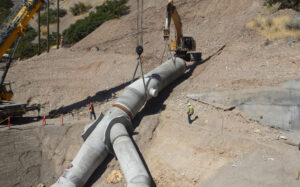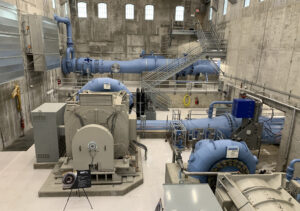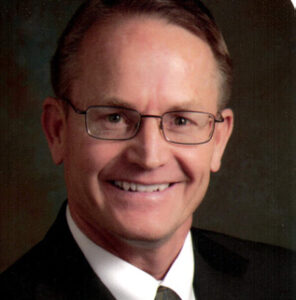Over the last 7 years, the Central Utah Water Conservancy District (CUWCD) has replaced the historic Olmsted power plant and transformed the century-old original building into a heritage feature. The early-priority-date water right associated with the full capacity of the original plant means that its continued operation is critical to the CUWCD’s continued ability to store sufficient water for the federal Central Utah Project (CUP). In this interview, CUWCD General Manager Gene Shawcroft discusses the complex water right situation and the intricacies of restoring and replacing a National Register of Historic Places–listed facility.
Hydro Leader: Please tell us about your background and how you came to be in your current position.
Gene Shawcroft: I am the general manager of the CUWCD. We operate the federal CUP, which is the largest water development project in the state of Utah. We have tremendous employees who work hard to operate and maintain a project that is important to the state of Utah and the region. I’ve been with the district since 1991, when I started as a staff engineer. I became an assistant general manager a number of years ago, then deputy manager, and I’ve been the manager now for a little over 5 years. I’ve been involved with water my entire career. I grew up on a little farm in Colorado and enjoyed working in water while I was there. I felt that if I could have a career in the water world, life would be fabulous, and it has been. The CUWCD is a wonderful place to work, and I’ve enjoyed all I do here.
Hydro Leader: Please tell us about the CUWCD.
Gene Shawcroft: The CUWCD was created in 1964 to be the sponsoring and repayment entity of the federal CUP. At the time we were created, there were 12 counties in the district. We have 8 counties now, since 4 withdrew from the district as the CUP was reformulated. Over the course of time, as the Bureau of Reclamation was constructing the CUP, it became obvious that additional funds would be needed from Congress. In 1992, Congress passed Public Law 102‑575, the Central Utah Project Completion Act, which made some landmark changes. First, the CUWCD rather than Reclamation became responsible for the completion of the CUP, and we were required to come up with a 35 percent local cost share. We had to have 90 percent subscription for the water in order to build the project. For the purposes of various environmental laws, principally the National Environmental Policy Act (NEPA), we became a federal agency. Our construction responsibilities changed dramatically, as did our coordination with the U.S. Department of the Interior. Rather than reporting through Reclamation, we now report directly to the assistant secretary of water and science, which improves the efficiency of the construction of the CUP and the efficiency of its operation and maintenance today.

Hydro Leader: What is the distinction between the CUWCD and the CUP?
Gene Shawcroft: The CUP is a federally owned project. The CUWCD is a state agency that has the contracts for the use of the water and is also responsible for the repayment of the CUP.
Hydro Leader: What role does hydropower play in the CUWCD’s overall operations?
Gene Shawcroft: We have an allocation of power from the Colorado River Storage Project, which we use at various locations throughout the district. In addition, we have a power plant at Jordanelle Reservoir, which we own under a lease of power privilege, and the Olmsted plant, which is a
federal facility and generates federal power. Both of these power plants make up a small portion of the value of the facilities we operate. We operate around $3.5 billion worth of federal facilities, and the Olmsted plant is valued at about $42 million. It is a relatively minor portion of the capital investment of the project, but it is critical to our operations.
Hydro Leader: Tell us about the history of the Olmsted plant.
Gene Shawcroft: The historical value of the Olmsted power plant can’t be overstated. It is one of a kind and was the first of its kind in many respects related to power. At one point in time, it was a hands-on educational facility for operators and held state-of-the-art technology. George Westinghouse himself was here for several years as he developed the concepts of alternating current. The plant is on the National Register of Historic Places. In our work on Olmsted, the Utah State Historical Preservation Office required us to not restore but to maintain the equipment in a heritage preservation–type fashion. We’ve spent quite a bit of time and money to do that.
The power produced by this plant is incidental to our operations. However, the water right associated with the power is critical to the operation of the CUP. The Olmsted power plant and facilities became part of the federal project in the mid-1980s for two purposes. First, there was a pipeline that took water from the Provo River into our distribution system. The right of way for that pipeline was key for getting water to our facilities. Second, the power plant’s water right was early priority. Even though it was a nonconsumptive right, the power plant, combined with other CUP rights, preserved our ability to store water in upstream reservoirs. An important settlement purchase agreement of the power plant and water rights in 1990 paid the owner, PacifiCorp, about half the settlement value. PacifiCorp continued to operate the plant and receive energy it produced to make up for the remaining capital cost until at least 2015 while allowing the CUWCD to store the water in Jordanelle Reservoir, where it formed an important part of the CUP water supply.
When the agreement we had with the power company expired in 2015, in order for us to maintain the water right that allowed us to store water in Jordanelle Reservoir, the power plant had to be operational. Parts of it were over 100 years old, so it was much more efficient to rebuild it than to refurbish it. Even though there are times when it does not generate power because we’re storing the water in Jordanelle for delivery to customers, the power plant’s water right is what actually maintains our ability to store water. That will continue to be the case in the future. The ability to generate power firms up our water right, which we mainly use to store water for the CUP.
Hydro Leader: In other words, the early priority water right is directly linked to the generation of power and cannot be transferred to another use without losing its priority date?
Gene Shawcroft: Correct. Let’s say that in the early spring, when the water in the river starts to increase because of runoff, the water could be diverted from the river and put in the power plant to generate power. At times, we physically store the water in a reservoir above the diversion, preventing it from coming to the diversion and storing it for use at a different time. We could allow the power company to continue to generate on the remaining water or pay a minimum guaranteed revenue to the power company to offset the revenue it would otherwise have made by generating power with that water. The power company is made whole to the total valuation of the settlement plus any additional generation, and we can store the water for delivery at a later time. The water right for the water that would have otherwise gone through the power plant is a nonconsumptive right. To replace that water, we purchase water downstream of the plant. That way, we keep everybody whole while having the ability to store water that we otherwise would not have been able to store. It’s a complicated exchange, but the bottom line is that everyone is kept whole, and yet we are able to store water in Jordanelle that allows us to make deliveries during July, August, and September when there otherwise would not be enough water for the project.
Hydro Leader: Tell us about the process of replacing the older power plant.
Gene Shawcroft: A few years before the expiration of the contract with the power company in 2015, we began preliminary investigations into whether it made sense to rehabilitate the old plant. As we looked at the equipment and the penstocks, it became obvious that the equipment had reached the end of its useful life. The power company knew that its contract terminated in 2015, so its level of maintenance was not what it otherwise would have been. We began a design process for the equipment and installation of a new plant.
In addition to the water from the natural Provo River drainage, we get water to this point from another source that comes through a pipeline from Strawberry Reservoir. This water has enough head to be connected to the penstocks to generate power at the power plant. If we turn the power plant off, there’s enough pressure to run the water from Strawberry up the penstock into our distribution system. We saved a lot of money by designing a system to allow flow in both directions. The power plant was taken out of commission in 2015. We had part of the design done prior to that time, because we didn’t want to have the plant shut down for a long period of time. That could have jeopardized our water right. We issued a notice to proceed on the prepurchase of equipment contracted in September 2015 and started installation 1 year later, in 2016. The construction occurred from September 2016 to August 2018. It was an investment of about $42 million. We began generation in July 2018 and started commercial production in October 2018.
Hydro Leader: You mentioned that you had to preserve elements of the historic plant in a heritage preservation form. Were any elements of it preserved in working form?
Gene Shawcroft: There were four different penstocks in the old project. Each penstock led to one individual generating unit. One of the penstocks had been completely shut down because the pipe had rusted through and had holes in it. We removed all four penstocks and replaced them with one larger penstock. Just prior to reaching the new plant, the penstock bifurcates to run two larger units and two micro units. The scroll cages and the runners for the four units in the old power plant are still there, but nothing in the old power plant is operational. The water and power have been completely disconnected. There are a couple of places in scroll cages where we’ve cut out a section so you can see into the runners and the wicket gates. The primary improvements to the historic building were for seismic performance.

Hydro Leader: What were the results of the project? How is the current project operating? Is it making you money?
Gene Shawcroft: It’s operating as we anticipated. It’s a run-of-river plant. We do not have the authority to run water through it solely for the purposes of generating power. Power generation is really incidental to it. As far as making money is concerned, because we rebuilt it in order to maintain our water right, there was never an expectation that we would generate a positive revenue stream. Whatever we generate goes straight to the Western Area Power Administration (WAPA), and a formula determines who gets how much power from the generation. The cost of that power is based on the district’s annual operational and maintenance costs for the year, plus WAPA’s oversight costs. It varies depending on the cost to operate and the amount of energy generated.
The district, with assistance of Interior, put capital into the power plant, but the district doesn’t anticipate getting it back. Our priority was maintaining the CUP water rights with the early priority date. If the power plant didn’t have the capacity for the full water right, we would not be able to store that amount of water when it is available. Our design engineers had a tough time understanding the need to design it for this large capacity when, in fact, the full amount of water is not available the majority of the time. We had to maintain the capacity of the plant in order to maintain our water right. If the most efficient size for the plant were only half the water right and we had built it at that size, we would have lost the other half of the water right. Because we had to build units large enough to carry the full capacity of the water right, those units may only run at full capacity for a few weeks a year, or in a dry year, perhaps not at all. In a wet year, they might run at full capacity for 2–6 months. The figures for return on investment were different from those of a normal power plant’s, simply because we designed the plant based on our desire to maintain the water right, not generate revenue.
Hydro Leader: What lessons about restoring historic power plants have you drawn from your experience with the Olmsted plant?
Gene Shawcroft: There are a lot of intricacies, and the expenses are not low. The district staff, consultant engineers, and contractors did a tremendous job maintaining the historic value of the power plant. There are many other buildings there, including an old classroom and the house of ideas, where they had some electric appliances that were among the first in the country. Some of those have hazards in them, such as asbestos, so we did not restore all of them. We only restored the old power plant, which is what we were required to do under our environmental commitments. The district also completed 3-D LIDAR surveying of all the miscellaneous outbuildings that had to be demolished where the new plant was constructed. It takes a little longer than you expect, and it takes a little more money than you expect. In the end, it was well done. We’re still trying to piece together all the information and all the plaques and other materials that we’ll need for the heritage center.
I’ve also learned that there are people who are passionate, and rightly so, about historic buildings and their historic value, including some of our staff, who have absolutely loved working on the project. It’s been interesting to see how some of our staff have adopted it as their own crusade to maintain as much historic value as possible.
Hydro Leader: Is there anything else you would like to add?
Gene Shawcroft: It’s always wonderful to me when the general public, to whatever degree, learns of the complexity that goes into making our lives convenient. An incredible amount of effort and expense went into this power plant as part of a larger picture to make sure people in our area get a safe and clean drink of water. I’m always thrilled that people are interested enough to learn about the complexity of what it takes to develop and use our natural resources, especially our water.
Gene Shawcroft is the general manager of the Central Utah Water Conservancy District. He can be contacted at gene@cuwcd.com.

